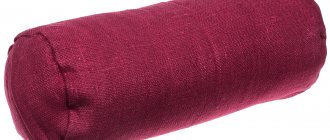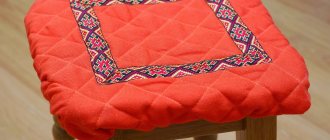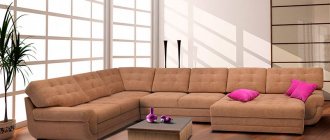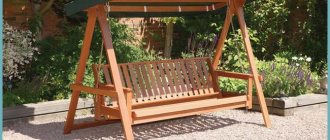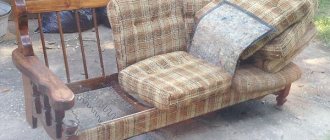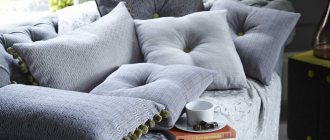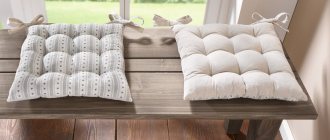Deciding on the sizes
Of course, you should start by determining the size of the pillow. To make a product “for yourself” as accurately as possible, use the following recommendations.
- The height of the pillow is a calculated value. Depends on the size parameters of the person for whom it is intended. Measure the distance from the ear (visually a vertical line lowered from it to the shoulder) to the edge of the shoulder. The resulting value will be the optimal height of the product.
- Analyze the moment in which position you prefer to spend most of the night. If your favorite position is sleeping on your back, the pillow should be slightly lower and denser. For those who prefer to sleep on their stomach, a soft, low pillow is suitable.
- Another factor to consider is the characteristics of the mattress. The harder and denser the mattress, the lower the pillow under your head should be.
Reference! Making a pillow with your own hands is an excellent opportunity to try it on and ultimately adjust the product to your parameters as much as possible. Do not immediately sew up the hole through which you insert the filler. Tack it with running stitches, test the pillow by adding or subtracting the amount of filling. Once the ideal result is achieved, the hole can be stitched.
Deciding on the form
As for the shape, it all depends on your personal preferences. For the head option, a regular - classic - square or rectangular head is suitable. For travel - in the form of a bagel. For pregnant women - in the shape of a banana or the Latin letter U. Another newfangled option is a hugging (or body) pillow, which can be made in the shape of the letters G, I, C, P or G and be the size of a human being.
What materials to use
You should not be afraid of the task at hand. As practice shows, it is possible to sew a product without professional skills and in-depth knowledge of sewing. The main thing is to choose the right materials and scrupulously approach the task at hand.
For a confidant
Teak is still considered the most optimal fabric for making bedsteads. This option is especially relevant if you intend to fill the pillow with feather or down. If any of the artificial materials will be used as a filler, calico, ranfors, linen, poplin, satin, polysatin, jacquard, flannel, polycotton, knitted fabric, microfiber, percale, polyester, knitted velor can be used to sew the bedstead.
As a filler
Down, feather and wool, although they belong to a series of natural fillers, are still not the best option. These materials require regular cleaning, are excellent dust collectors and a favorable environment for the life of dangerous microorganisms that cause and aggravate allergic reactions. In addition, they quickly lose their shape.
In view of this, it is better to give preference to modern artificial materials. The following can be excellent hypoallergenic, springy fillers:
Hollofiber Practical, durable, springy material that is easy to care for. Siliconized fibers twisted into “springs” quickly restore their original shape after compression. Safe and hypoallergenic. Characterized by excellent thermal insulation and ventilation. Washable.
Holofiber filler.
Comforel Ball-shaped siliconized “granules”. Compared to holofiber, it is softer and less durable. Nevertheless, it holds its shape well, retains heat and is well ventilated. Does not accumulate odors. Washing is allowed.
Silicone “Sheet” holofiber. Hypoallergenic, well ventilated material. May have different degrees of density.
Synthetic fluff Soft, springy filler. Retains heat and is well ventilated. Easy to use, great material.
polystyrene Foamed polymer with a crumbly structure (in the form of miniature balls). An unusually lightweight material consisting of 98% air. A distinctive feature of products filled with expanded polystyrene granules is their neutrality to external temperatures (does not heat up from the body). Belongs to the category of semi-rigid fillers. The only inevitable drawback is a slight rustling sound from the friction of the granules against each other.
Reference! Synthetic winterizer is not recommended as a filler. Hypoallergenic and budget synthetic padding polyester is not elastic enough, holds its shape worse and quickly becomes loose.
Variants of the listed fillers, as a rule, are easy to purchase even in small cities (or on the Internet).
Unusual fillers
Buckwheat husks and cherry pits Natural fillers with a therapeutic effect. They do not harbor dust mites, which is important. The downsides include the rustling sound the pillows make and difficulty in cleaning. Products cannot be washed. Pillows with buckwheat husks and cherry pits are not intended for regular night sleep, as these fillers are not orthopedic enough.
Herbal pillows A hot topic for aromatherapy lovers. Before you start creating a grass pillow, you should familiarize yourself with some important nuances. For example, keep in mind that fragrance is a kind of medicine and should be selected carefully. Since the herbs themselves do not hold their shape well, sedge, fireweed fluff, heather or straw are used as a base. Herbs must be fresh and well dried. The service life of such pillows is 1-2 years, subject to storage rules.
Orthopedic fillers
Orthopedic pillow fillers include natural latex, polyurethane foam and viscoelastic foams (memory type). In principle, if you wish, you can even find such fillers (sheet versions) on sale. It is unlikely that it will be possible to depict an ergonomic wave-like or massage version (although for those who are especially persistent, nothing is impossible), but a rectangle or square is quite possible.
For pillowcase
The range of fabrics from which you can make a cover or pillowcase is huge - for every taste and budget.
Chintz
The most affordable option. Has an incredibly wide variety of colors. Hygroscopic material - perfectly breathable and absorbs moisture. At the same time, it is not durable enough, is not resistant to abrasion, and shrinks when washed (before cutting, it is better to soak a piece of fabric in water at the temperature in which you will subsequently wash the pillowcases).
Satin
A more expensive, practical, comfortable option. Beautiful and durable fabric.
Natural silk
Expensive, luxurious material with thermoregulating properties. Quite demanding in care.
Poplin
A noble fabric created from cotton and silk fibers. More durable and less fussy than 100% silk.
Linen
Linen for bed linen often implies the presence of cotton fibers (for softness). Very practical and durable material. The disadvantages include high creasing and difficulty in ironing.
Bamboo
Durable fabric with properties typical of viscose materials. It is not natural, although it is produced from individual parts of the bamboo plant.
Velor and terry
Modern, original, durable fabrics, warm and soft. They absorb moisture well and do not slip.
Tools
In addition to having the necessary materials, you will need the following tools:
- threads in the color of the fabrics
- measuring tape, ruler
- cutting scissors
- tailor's pins
- sewing machine
- zipper length 25 cm
- pattern paper and pencil
- sharpened soap or chalk
Properties of pillow filling
The internal filling of sleeping pillows should be made of hypoallergenic materials.
Depending on the purpose of the pillow, the requirements for the internal filling of the product will also vary. As a filler for decorative and sofa pillows, you can use synthetic winterizer, scraps of knitted fabric, cotton wool and other inexpensive materials that any housewife has in abundance. Here you need to be more careful when choosing a cover. This pillow is used throughout the day; the fabric gets dirty quickly, which means it should be easy to wash and dry quickly.
If you decide to make a bedding, special attention should be paid to the following properties of the filler:
- elasticity - the pillow should hold its shape well, not deform during movements, and quickly restore its volume;
- breathability - the filler and the fabric from which the cover is made must fully allow air flow and not interfere with human breathing;
- hypoallergenic - the internal filling of bedding must be made of materials that do not cause allergies;
- ease of care - the pillow should be easy to wash; It is very convenient if you can use an automatic machine for washing.
Today you can find many synthetic fillers on sale, but many needlewomen prefer to use time-tested natural materials such as down and feathers. Those who like unusual solutions can pay attention to vegetable filler, which is used as buckwheat husks or dried herb leaves. Thus, the choice of material suitable for filling a homemade pillow depends entirely on the preferences of the housewife.
Carrying out work step by step
If you have stocked up on all the necessary materials and tools, you can start making the pillow. The algorithm for performing the work is as follows.
- Making a paper pattern. The dimensions and shape of the patterns depend on your preferences and the chosen model. Alternatively, you can take ready-made parameters from the Internet, or use someone else’s experience (pattern).
- Transferring the finished pattern onto the fabric. To avoid displacement, it is better to pin paper patterns to the fabric with tailor's pins. The pinned patterns are traced along the contour with a sharpened soap or cutting chalk.
- Reveal the details. The parts are cut out taking into account seam allowances (for stitching). The size of the allowance is 1-1.5 cm.
- Basting and stitching pillow parts. Pieces folded face to face are basted or pinned with tailor's pins (to avoid displacement during the stitching process). Sew down the parts, leaving the hole for inserting the filler free, and turn the napkin inside out onto your face.
- Filling. The pillow is slowly filled with filler, distributing it evenly. As mentioned above, the hole for inserting the filler should not be filled in immediately. It is better to “grab” it manually using running stitches (or sew in a zipper) and test the product for several days or nights. You may need to increase or decrease the amount of padding to achieve optimal comfort.
Synthetic materials
Sintepon
Today it is one of the cheapest synthetic materials, which perfectly serves as a filler for pillows, mattresses, blankets, and so on. Products based on synthetic padding have no foreign odors, are absolutely hypoallergenic, and bed mites and various harmful microorganisms will not live in them. Thanks to this, padding polyester pillows are completely safe for the human body. This material is very easy to care for - it can easily withstand both hand and machine washing, and after that it dries in just a couple of hours.
More: TOP 10 best inversion tables for the spine, how to choose the best model
Pillows based on padding polyester are elastic and light, not sensitive to moisture. This filler is characterized by high thermal conductivity - it will be very comfortable to sleep on the pillow even in extremely hot weather. When choosing products, you should look at the thickness of the fibers - you should give preference to products with thinner fibers. It is much more comfortable to rest on such pillows.
Advantages:
- Safe for human health;
- Insignificant mass;
- Good elasticity of the material;
- Resistant to moisture;
- Does not require special care.
Flaws:
- There are no orthopedic qualities.
Filler Sintepon
Gel
Such pillows are usually made on the basis of latex or special artificial foam with high viscosity, to which gel inserts are added. It is worth noting that this material is characterized by the presence of a memory effect. In other words, it is able to take on an individual shape, so the load on the spine will be significantly less. This makes this pillow perfect for pregnant women and small children.
The filler does not become dirty during use and dust does not accumulate in it, so it will be a good option for people who suffer from asthma or allergies. The material itself has a cooling effect, allows air to pass through it well, and is very easy to care for - periodically you will have to wipe it with a damp cloth.
Advantages:
- Hypoallergenic products;
- Perfect for children and women;
- The filler is easy to care for;
- Provides a cooling effect;
- Good orthopedic qualities.
Flaws:
- It's quite expensive.
Filler Gel
Memory foam
Pillows made from memory foam are absolutely environmentally friendly, do not cause allergic reactions and are of excellent quality. Under the weight of a person’s body and the heat it generates, the product will follow every contour of the head in great detail. Such a pillow improves the quality of sleep significantly, helps a person fully recover and rest within a short period of time. With its help, you can reduce the negative effect of osteochondrosis. The pillow is also perfect for pregnant women, for whom it is very important to completely relax and get a good night's sleep.
Foam-based pillows will last for quite a long time; they are characterized by increased strength and reliability. The filler easily passes air through itself, moisture evaporates almost instantly, and it also retains heat well.
Advantages:
- Excellent orthopedic characteristics;
- Optimal for allergy sufferers, patients with osteochondrosis, pregnant women;
- Passes air through itself;
- Excellent heat retention.
Flaws:
- Somewhat expensive.
Filling Memory foam
DIY travel pillow
If you travel often and for a long time, then you are familiar with the feeling of discomfort experienced every time you try to take a nap while sitting in a waiting room, in a car, bus, train or plane. Why not buy (or make your own) a travel pillow? It's actually very simple and won't take much time.
Travel pillows are usually shaped like a bagel or a horseshoe. It is this option that most comfortably supports the neck and head during “sedentary” sleep. To make such a pillow, use natural or mixed pleasant, non-slip fabric for the cover (usually fleece, flock, spandex, less often - polyester, nylon, cotton, linen, satin) and artificial filler (usually holofiber).
The principle of performing the work is similar to that described above.
- Making a paper pattern.
- Transfer the pattern to the fabric folded in half (face to face).
- Cut taking into account allowances.
- Sweeping or chipping parts.
- Sewing parts (don't forget to leave a hole for inserting filler!).
- Turn the product inside out and fill it evenly with filler.
- Sealing the hole.
Decorative pillows
All of the above principles apply equally to the production of decorative pillows.
Recommended fillers - holofiber, comforter, synthetic down, polystyrene foam granules, foam rubber (polyurethane foam), foam rubber crumbs.
The variations in sizes and shapes are limitless (you can come up with your own or choose any model you like from the Internet).
There are many more samples of materials for sewing pillowcases than for models for sleeping. Since the purpose of these pillows is to decorate the interior, the materials for pillowcases are not subject to very strict requirements in terms of naturalness and hygroscopicity. Any theme would be appropriate here - from furniture flocks and tapestries to natural and artificial fur, as well as patchwork and the use of accessories.
What can you stuff a pillow with?
Articles on the topic (click to view)
- The easiest way to tuck a blanket into a duvet cover
- Anti-wrinkle pillow
- How often should bed linen be changed?
- How to remove blood from a sheet
- How to choose good quality bedding
- Bamboo pillow: benefits and disadvantages
- Do I need to iron bed linen after purchasing or washing?
The variety of fillers on the modern market is impressive. Therefore, before deciding what to fill the pillow with, decide what exactly it is intended for.
For example, if we are talking only about a decorative pillow, then any available materials are quite suitable. If we are talking about poufs, then we need dense fillings, and for “seats”, on the contrary, soft materials are required.
And pillows for sleeping are a different story altogether. Despite the high cost, it is better to use natural fillers here, because we are talking primarily about health. Especially if someone in the family suffers from allergies.
As you can see, the range of packings is very wide and varied. Let's take a closer look at each of them separately.
